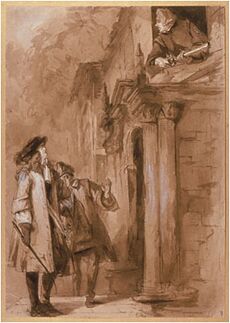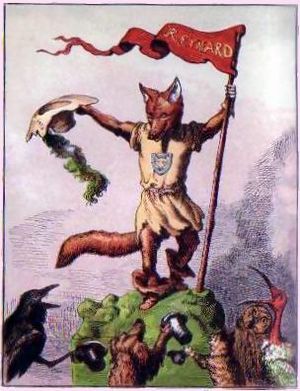محتال
في علم الأساطير ودراسة الفلكلور والأديان، المحتال (إنگليزية: trickster)، هو شخصية في قصة (أو تجسد ، الإنسان، الروح، الآلهة الإله) تملك درجة هائلة من الذكاء وأسرار المعرفة وتستخدمها لممارسة الحيل أو لخرق القواعد الاعتيادية وتحدي السلوك التقليدي.
علم الأساطير
يظهر المحتالون كشخصيات نموذجية في أساطير العديد من الحضارات المختلفة. يصف لويس هايد المحتال أنه "متعد للحدود". [1] غالباً ما يتعدى المحتال ويخترق القواعد الجسدية والاجتماعية: "ينتهك المحتالون مبادئ النظام الاجتماعي والطبيعي، يقاطعون سير الحياة بنحو متلاعب ويعيدون تأسيسها وقف أسس جديدة." [2]
عادة ما يأخذ خرق القواعد والتلاعب بها شكل الحيل أو اللصوصية. قد يكون المحتالون محتالين أو مغفلين أو يحملون الصفتين معاً. يشكك المحتال بصراحة بالسلطة أو يعرقلها أو يهزأ بها. غالباً ما تكون الشخصية ذكراً ومولعاً بخرق القواعد والتبجح وممارسة الحيل على البشر والآلهة.[بحاجة لمصدر]
لدى الكثير من الحضارات حكايات عن المحتالين، كائن ماهر يستخدم الخديعة ليحصل على الطعام وليسرق الممتلكات الثمينة أو ليتسبب بالأذى. في بعض الأساطير اليونانية، يلعب هرمس دور المحتال. إنه حامي اللصوص ومخترع الكب، وهي موهبة منحها لـأوتوليكاس والذي منحها بدوره إلى أوديسة. [1] في حكايات السلف الفولكلورية، غالباً ما يجتمع المحتال و البطل. [بحاجة لمصدر]
عادة، تغير شخصة المحتال جنسها و تغير الشكل. في علم الأساطير الاسكندنافية، لوكي هو صانع المشكلات وهو أيضاً متحول الشكل. يمتلك لوكي أيضاً القدرة على تغيير جنسه، حتى إنه كان حاملاً في إحدى الحالات. يتحول إلى فرس ويلد لاحقاً حصان أودن ذي الثماني أرجل سلبنر. [بحاجة لمصدر]
في نطاق واسع من المجتمعات المتحدثة بلغات إفريقية، يكون المحتال أرنباً أو ارنباً وحشياً. في غرب إفريقيا (ثم في الكاريبي عبر تجارة العبيد)، العنكبوت (أنانسي) هو المحتال عادةً. [3]
النمط الجسدي
المحتال أو المهرج مثال على النموذج الجونگي.
المحتال أو المهرج
المحتال مصطلح يطلق على 'مسبب المشكلات' غير المؤدي، قد يكون لديه عدة دوافع خلف نيته ولكن تلك الدوافع غير ظاهرة للعامة بل هي داخلية للشخصية أو الشخص.
بينما المهرج هو شخصية لمؤد يعرض تصرفاته في العلن متعمداً أمام الجمهور.
في الأدب
In modern literature, the trickster survives as a character archetype, not necessarily supernatural or divine, sometimes no more than a stock character.قالب:Cf
Often, the trickster is distinct in a story by his acting as a sort of catalyst; his antics are the cause of other characters' discomfiture, but he himself is left untouched. Shakespeare's Puck is an example of this. Another once-famous example was the character Froggy the Gremlin on the early USA children's television show "Andy's Gang". A cigar-puffing puppet, Froggy induced the adult humans around him to engage in ridiculous and self-destructive hi-jinks.[4]
For example, many European fairy tales have a king who wants to find the best groom for his daughter by ordering several trials. No brave and valiant prince or knight manages to win them, until a poor and simple peasant comes. With the help of his wits and cleverness, instead of fighting, they evade or fool monsters, villains and dangers in unorthodox ways. Against expectations, the most unlikely candidate passes the trials and receives the reward.قالب:Cf
More modern and obvious examples of the same type include Bugs Bunny in the USA and from Sweden the female hero in the Pippi Longstocking stories.
دوره في الأدب الأمريكي-الأفريقي
Modern African-American literary criticism has turned the trickster figure into an example of how it is possible to overcome a system of oppression from within. For years, African-American literature was discounted by the greater community of American literary criticism while its authors were still obligated to use the language and the rhetoric of the very system that relegated African Americans and other minorities to the ostracized position of the cultural "other." The central question became one of how to overcome this system when the only words available were created and defined by the oppressors. As Audre Lorde explained, the problem was that "the master's tools [would] never dismantle the master's house."[5]

في التقاليد الأمريكية الأصلية
While the trickster crosses various cultural traditions, there are significant differences between tricksters in the traditions of different parts of the world:
Many native traditions held clowns and tricksters as essential to any contact with the sacred. People could not pray until they had laughed, because laughter opens and frees from rigid preconception. Humans had to have tricksters within the most sacred ceremonies for fear that they forget the sacred comes through upset, reversal, surprise. The trickster in most native traditions is essential to creation, to birth.[6]
كيتوى
The Coyote mythos is one of the most popular among western Native American cultures, especially among indigenous peoples of California and the Great Basin.
According to Crow (and other Plains) tradition, Old Man Coyote impersonates the Creator: "Old Man Coyote took up a handful of mud and out of it made people".[7] He also bestowed names on buffalo, deer, elk, antelopes, and bear. According to A. Hultkranz, the impersonation of Coyote as Creator is a result of a taboo, a mythic substitute to the religious notion of the Great Spirit whose name was too dangerous and/or sacred to use apart from at special ceremonies.[بحاجة لمصدر]
In Chelan myths, Coyote belongs to the animal people but he is at the same time "a power just like the Creator, the head of all the creatures." while still being a subject of the Creator who can punish him or remove his powers.[8] In the Pacific Northwest tradition, Coyote is mostly mentioned as a messenger, or minor power.
As the culture hero, Coyote appears in various mythic traditions, but generally with the same magical powers of transformation, resurrection, and "medicine". He is engaged in changing the ways of rivers, creating new landscapes and getting sacred things for people. Of mention is the tradition of Coyote fighting against monsters. According to Wasco tradition, Coyote was the hero to fight and kill Thunderbird, the killer of people, but he could do that not because of his personal power, but due to the help of the Spirit Chief. In some stories, Multnomah Falls came to be by Coyote's efforts; in others, it is done by Raven.
More often than not Coyote is a trickster, but always different. In some stories, he is a noble trickster: "Coyote takes water from the Frog people... because it is not right that one people have all the water." In others, he is malicious: "Coyote determined to bring harm to Duck. He took Duck's wife and children, whom he treated badly."[بحاجة لمصدر]
في الإنترنت والوسائط المتعددة
In online environments, there has been a link between the trickster and Internet trolling. Some have said that a trickster is a type of online community character.[9][10]
في الحكايات المروية

- Abenaki mythology: Azeban
- African mythology: Ekwensu
- Afro-Cuban mythology: Eleggua, Eshu
- Akan mythology: Kwaku Ananse
- American folklore: Brer Rabbit (or Compere Lapin) and Aunt Nancy, a corruption of Anansi (Anansee)
- Arabian mythology: Juha, Sinbad
- Ashanti folklore: Anansi
- Australian Aboriginal mythology: Bamapana, Crow
- Aztec mythology: Huehuecoyotl
- Babylonian mythology: Lilith
- Bantu mythology: Hare (Tsuro or Kalulu)
- Basque mythology: San Martin Txiki
- Belgian mythology: Lange Wapper
- Brazilian folklore: Saci, Curupira
- Bulgarian/Macedonian folklore: Hitar Petar (Itar Pejo)
- Bushmen/San Folklore: Cagn
- Caribbean folklore: Anansi
- Celtic mythology: Fairy, Puck, puca
- Chinese mythology: Huli jing (Fox spirit), Nezha, Red Boy, Sun Wukong (Monkey King)
- Cree mythology: Wisakedjak
- Crow mythology: Awakkule, Mannegishi
- Dutch folklore: Reynaert de Vos, Tijl Uilenspiegel
- Egyptian mythology: Set, Isis
- English folklore: Robin Hood, Puck, Brownies
- Fijian mythology: Daucina
- French folklore: Renart the Fox
- German folklore: Reineke Fuchs, the Pied Piper, Till Eulenspiegel
- Greek mythology: Eris, Prometheus, Hermes, Odysseus, Sisyphus, Dolos
- Haitian folklore: Anansi, Ti Malice
- Hawaiian mythology: Kaulu, Kupua
- Hindu mythology: Baby Krishna (stealing butter), Narada, Mohini, Hanuman (shapeshifting and teasing sages).
- Hopi and Zuni mythology: Kokopelli
- Igbo mythology: Mbeku
- Indonesian folklore: Kantjil, or kancil in modern orthography (spelling).
- Inuit mythology: Amaguq
- Irish folklore: Leprechauns, Briccriu
- Islamic mythology: Iblis, Khidr, Nasreddin
- Italian folklore: Giufà (Sicily), Pulcinella (Naples)
- Japanese mythology: Kitsune, Susanoo, Kappa, Bake-danuki, Hare of Inaba
- Jewish folklore: Hershele Ostropoler (Ashkenazi), Joha (Sephardic)
- Kazakh folklore: Aldar kose
- Kiowa folklore: Saynday
- Kongo mythology: Moni-Mambu
- Korean folklore: Kumiho, Dokkaebi
- Lakota mythology: Iktomi, Heyoka
- Latin American and Spanish folklore: Pedro Urdemales (Pedro Malasartes in Portuguese)
- Levantine mythology: Yaw
- Māori mythology: Māui
- Mayan mythology: Maya Hero Twins, Kisin
- Micronesian mythology: Olifat
- Miwok mythology: Coyote
- Nigerian mythology: Agadzagadza
- Norse mythology: Loki
- Norwegian mythology: Espen Askeladd
- Northwest Caucasian mythology: Sosruko
- Ohlone mythology: Coyote
- Ojibwe mythology: Nanabozho
- Philippine mythology: Nuno sa Punso, Tikbalang, Pilandok
- Polynesian mythology: Maui
- Pomo mythology: Coyote
- Pueblos dancing: Koshares
- Romanian mythology: Păcală
- Russian folklore: Ivan the Fool
- Slavic mythology: Veles
- Spanish mythology: Don Juan, The Trickster of Seville
- Sumerian religion: Enki
- Tibetan folklore: Akhu Tönpa,
- Thai folklore: Sri Thanonchai
- Tumbuka mythology: Kalulu
- Ute mythology: Cin-an-ev
- Vodou: Papa Legba, Ti Malice, Baron Samedi
- Welsh mythology: Gwydion, Taliesin, Morgan Le Fay
- West African mythology: Anansi
انظر أيضاً
- Grotesque body
- Claude Lévi-Strauss's The structuralist approach to myth
- Malandro, the traditional Brazilian folklore trickster.
- Miwok Coyote and Silver Fox
- Native Americans in the United States
المصادر
- ^ أ ب Hyde, Lewis. Trickster Makes This World: Mischief, Myth, and Art. New York: Farrar, Straus and Giroux, 1998.
- ^ Mattick, Paul (February 15, 1998). "Hotfoots of the Gods". New York Times.
- ^ Haase, Donald (2008). The Greenwood Encyclopedia of Folktales and Fairy Tales. Greenwood Publishing Group. pp. 31. ISBN 978-0-313-33441-2.
- ^ Smith, R. L. "Remembering Andy Devine".
- ^ Lorde, Audre (2004). "Age, Race, Class, and Sex". In Rivkin, Julie; Ryan, Michael (eds.). Literary Theory: An Anthology. Oxford: Blackwell Publishing. p. 859.
- ^ Byrd Gibbens, Professor of English at University of Arkansas at Little Rock; quoted epigraph in Napalm and Silly Putty by George Carlin, 2001
- ^ "Gold Fever California on the Eve- California Indians", Oakland Museum of California
- ^ Edmonds, Margot; Ella E. Clark (2003). Voices of the Winds: Native American Legends. Castle Books. p. 5. ISBN 0785817166.
- ^ Campbell, J., G. Fletcher & A. Greenhill (2002). "Tribalism, Conflict and Shape-shifting Identities in Online Communities." In the Proceedings of the 13th Australasia Conference on Information Systems, Melbourne Australia, 7–9 December 2002.
- ^ Campbell, J., G. Fletcher and A. Greenhill (2009). "Conflict and Identity Shape Shifting in an Online Financial Community", Information Systems Journal (19:5), pp. 461–478. DOI:10.1111/j.1365-2575.2008.00301.x.
المراجع
- Gates, Henry (2004), "The Blackness of Blackness: A Critique on the Sign and the Signifying Monkey", Literary Theory: An Anthology (Oxford: Blackwell Publishing)
- Earl, Riggins R., Jr. (1993). Dark Symbols, Obscure Signs: God, Self, And Community In The Slave Mind. Maryknoll, New York: Orbis Books.
{{cite book}}: CS1 maint: multiple names: authors list (link) - Bassil-Morozow, Helena (2011). The Trickster in Contemporary Film. Routledge.
- Ballinger, Franchot; Vizenor, Gerald (1985). "Sacred Reversals: Trickster in Gerald Vizenor's 'Earthdivers: Tribal Narratives on Mixed Descent'". American Indian Quarterly. 9 (1, The Literary Achievements of Gerald Vizenor): 55–59. doi:10.2307/1184653. JSTOR 1184653.
- Ballinger, Franchot (1991). "Ambigere: The Euro-American Picaro and the Native American Trickster". MELUS. 17 (1, Native American Fiction: Myth and Criticism): 21–38. doi:10.2307/467321. JSTOR 467321.
- Boyer, L. Bryce; Boyer, Ruth M. (1983). "The Sacred Clown of the Chiricahua and Mescalero Apaches: Additional Data". Western Folklore. 42 (1): 46–54. doi:10.2307/1499465. JSTOR 1499465.
- Datlow, Ellen and Terri Windling. 2009. The Coyote Road: Trickster Tales. Firebird.
- California on the Eve - California Indians Miwok creation story
- Joseph Durwin Coulrophobia & The Trickster
- Koepping, Klaus-Peter (1985). "Absurdity and Hidden Truth: Cunning Intelligence and Grotesque Body Images as Manifestations of the Trickster". History of Religions. 24 (3): 191–214. doi:10.1086/462997. JSTOR 1062254.
- Lori Landay Madcaps, Screwballs, and Con Women: The Female Trickster in American Culture 1998 University of Pennsylvania Press
- Paul Radin The trickster: a study in American Indian mythology (1956)
- Allan J. Ryan The Trickster Shift: Humour and irony in contemporary native art 1999 Univ of Washington ISBN 0-7748-0704-0
- Trickster's Way Volume 3, Issue 1 2004 Article 3 "Trickster and the Treks of History".
- Tannen, R. S., The Female Trickster: PostModern and Post-Jungian Perspectives on Women in Contemporary Culture, Routledge, 2007
وصلات خارجية
 Media related to Tricksters at Wikimedia Commons
Media related to Tricksters at Wikimedia Commons- Joel Chandler Harris and the Uncle Remus Collection
خطأ لوا في وحدة:Authority_control على السطر 278: attempt to call field '_showMessage' (a nil value).
- Articles with hatnote templates targeting a nonexistent page
- Articles containing إنگليزية-language text
- Pages using Lang-xx templates
- مقالات ذات عبارات بحاجة لمصادر
- Articles with unsourced statements from July 2015
- Articles with unsourced statements from September 2016
- محتالون
- طرز بدنية أسطورية
- طرز بدنية أدبية


